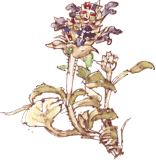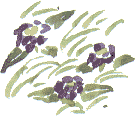
|
Self-HealSaturday, 28th June 2003, West Yorkshire |
![]()
![]()
![]()
![]() Rocks | History |
Workshop |
Links | Home
Page
Rocks | History |
Workshop |
Links | Home
Page
![]()
 Self-heal,
Prunella vulgaris, is establishing itself on my mother-in-law's
lawn, particularly on the front lawn on a north-facing banking alongside
the pavement.
Self-heal,
Prunella vulgaris, is establishing itself on my mother-in-law's
lawn, particularly on the front lawn on a north-facing banking alongside
the pavement.
It doesn't grow this tall on my Mum's lawn, which gets mown to within an inch of its life at frequent intervals. My's Mum's self-heal is flowering at the moment but it's a bonsai version of the blooms on Barbara's Mum's lawn, with tiny flower-heads the size of small currants. The plant spreads by runners across the turf.
 The
leaves contains tannins which act as a phenol, an aromatic hydrocarbon,
to stop bacteria from multiplying. Carbolic acid is an example of a phenol
which is used, in dilute form, as a disinfectant.
The
leaves contains tannins which act as a phenol, an aromatic hydrocarbon,
to stop bacteria from multiplying. Carbolic acid is an example of a phenol
which is used, in dilute form, as a disinfectant.
The leaves, which also contain bitters and an essential oil can be made into a tisane to soothe sore throats when used as a gargle, although David Bellamy warns, in Blooming Bellamy, that too much tannin can have to opposite effect.
Here's what Culpeper has to say:
This is under Venus, and is a special remedy for inward and outward wounds. Taken in syrups for inward wounds ; for outward wounds in unguents and plasters . . . it will also . . . cleanse the foulness of sores, and speedily heal them. . . Anoint the temples and forehead with the juice and the oil of roses, to remove the headache ; the same mixed with honey of roses, cleanses and heals all ulcers in the mouth and throat, and those also in the secret parts.
Culpeper's Complete Herbal, 1653
I should warn you not to try this at home! - it sounds like powerful stuff. Although I might just try a sip of self-heal tea, just to see how bitter it is.
 Medieval
herbalists used the doctrine of signatures as a clue to what use a medicinal
herb might be put: the upper lip of the self-heal flower is sickle-shaped
and this was taken, rightly it seems, to suggest that the plant could
be used to treat wounds. At harvest and hay-cutting time sickle wounds
were a common.
Medieval
herbalists used the doctrine of signatures as a clue to what use a medicinal
herb might be put: the upper lip of the self-heal flower is sickle-shaped
and this was taken, rightly it seems, to suggest that the plant could
be used to treat wounds. At harvest and hay-cutting time sickle wounds
were a common.
![]()
![]() Next page |
Previous page | This
day in 2000 | This month |
Nature Diary |
Home
Page
Next page |
Previous page | This
day in 2000 | This month |
Nature Diary |
Home
Page
![]()